Saturday, July 09, 2005
Billon antoninianus, Gallienus, Köln, Göbl 875d
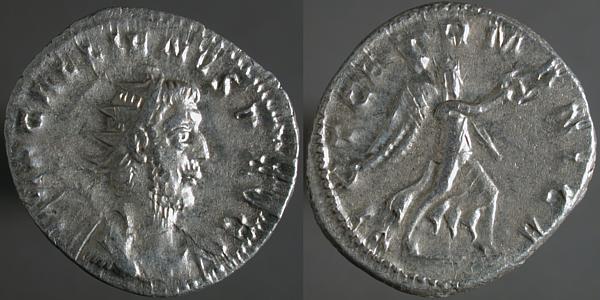
IMP GALLIENVS P AVG, Radiate cuirassed bust right | VICT GERMANICA, Victory advancing right, trophy over shoulder, holding wreath right.
The trophy was an old tradition, preceeding the Romans: a wooden framework holding the arms and armor of a vanquished enemy, making who'd won, and who lost, visible.
I think my clearest image of a trophy is on this coin, issued from the same mint as today's post.
Friday, July 08, 2005
Meta, meta, meta
Two additions to the links over on the right of the screen:
The Shekel - Coins, Law and Commentary, an active blog which needs to post more coins.
English & Napoleonic Coins, the blog of an US seller of English Hammered and Napoleonic coins.
Æ20, Ephesus in Ionia, Gallienus, unknown
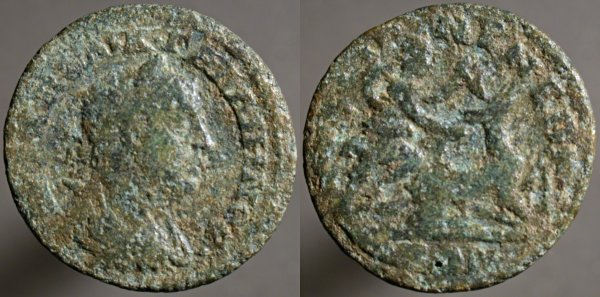
[AYT K ΠO] ΛIK ΓAΛΛIHNOC, Laureate draped bust right | EΦEC_I_ΩN Γ NEΩKO / PΩN, Artemis standing right, seizing fallen stag by the horns, stabbing neck with dagger.
This one's interesting: the reverse is very similar to that on this coin of Valerian minted at Hadriani ad Olympum in Mysia. As this map shows, Mysia and Ionia (both on the Eastern shore of the Aegean Sea, share a border, but Ephesus is far from that border, and it seems unlikely that these two cities would have shared facilities.
It may be, of course, that one copied the work of the other, or that both were copying the image of a well-known art-work.
I speculate wildly that it's also possible that minting coins was sometimes farmed out to businessmen who may have relocated when the commission from one city was lost to seek work in another city.
Thursday, July 07, 2005
Silvered Æ antoninianus, Gallienus, Mediolanum, Göbl 1243i
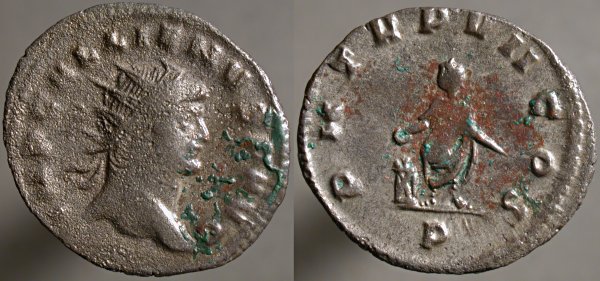
IMP GALLIENVS P AVG, Radiate head right, both ribbons behind | P M TR P VII COS, Emperor, radiate, standing facing, head left, holding scepter right, sacrificing from patera over altar left. P in exergue.
Since Gallienus is stated here to be Pontifex Maximus (the P M at the beginning of the reverse legend) and we know that there was only one Pontifex Maximus at a time and that the office was for life, this was minted after Valerian was dead, or considered effectively so following his capture by Shapur.
Since he's further stated to have tribunician power for the seventh time (TR P VII), which occurred in September 258, followed a year later by his being granted the power for the eighth time. While the loss of Valerian to Shapur is often stated to have happened in 260, this coin seems to support the idea that it was no later than September 259.
Wednesday, July 06, 2005
Æ26, Viminacium in Moesia Superior, Aemilian, 253 CE, Sear 4402var
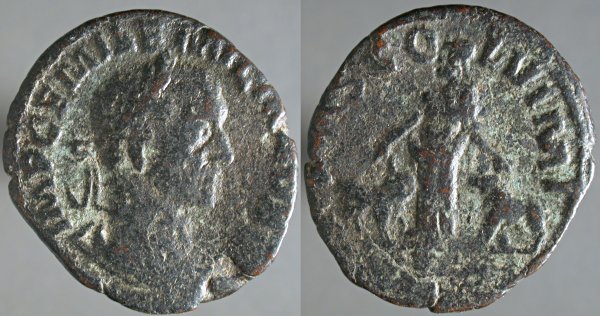
IMP C EMIL EMILIA[NVS AVG], Laureate draped bust right | [PM]S COL VIMI, Tyche standing, head left, with bull right in left field and lion left in right field. Era date [AN XIV] in exergue obscure.
Marcus Aemilius Aemilianus, governor of Moesia Inferior, after successfully driving Goths out of his province, continued on towards Rome. In mid-253, within a few days march of the city, his forces met those of Trebonianus Gallus who, seeing themselves outnumbered and outmatched by those of the usurper, turned on their emperor and killed him.
By the time Aemilian was recognized by the Senate Valerian was already marching his armies toward Rome. 88 days later they arrived and Aemilian's legions, finding themselves outnumbered and outmatched, followed the example of Gallus's forces.
Because he reigned for less than three months, coins of Aemilian are not common. As Viminacium is close to where he was acclaimed emperor by his troops, they may have begun minting for him here before the issue was decided. (Since Aemilian's reign was all within a single year, I know what the date, in the exergue of this coin, is even if I can't read it.)
Tuesday, July 05, 2005
Æ32, Sagalassus in Pisidia, Valerian, SNG von Aulock 5198
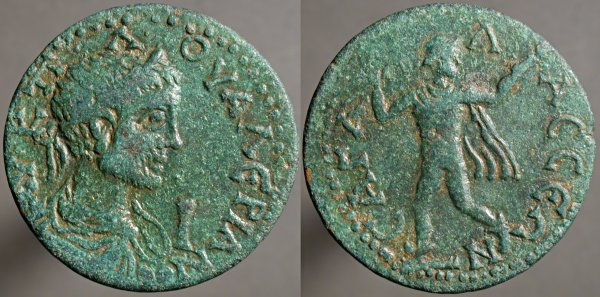
[A]V K Π Λ OVAEPIANOC, Laureate draped cuirassed bust right, I before | CAΓA_Λ_ACCEΩ_N, Hermes fully clothed, wearing cape, winged boots, and petasos running left, holding caduceus looking back right.
One of the prettiest patinas I own, an even lime color I especially appreciate on bronze coins, along with only moderate wear and legends that are legible, even if not perfectly so. A thoroughly acceptable coin.
Monday, July 04, 2005
Æ antoninianus, Gallienus, Mediolanum, Göbl 1211g
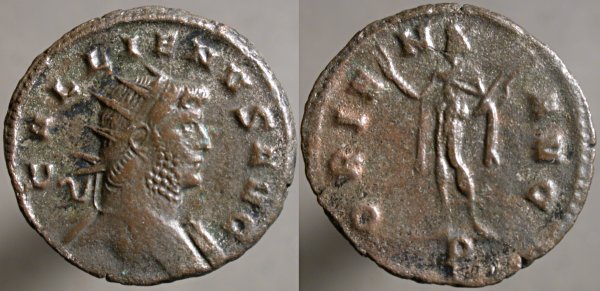
GALLIENVS AVG, Radiate head right, slight drapery on both shoulders | ORIENS AVG, Radiate Sol standing facing, head left, holding whip right, hand raised left. P in exergue.
Göbl groups this in a complex little series from the mint at Mediolanum, today's Milan; this reverse issued from both this Primary officina and a Secondary one (and a few coins with no mark for the officina), paired with four different obverse legends. It was, it seems, issued over a fairly long period of time, while the mint changed many details, fresh dies prepared for each change. Perhaps someone at the mint particularly favored Sol.
Göbl attests (but does not plate) a single example of this combination, on the authority of Die Römer in Bayern by Hans-Jörg Kellner. I purchased this coin from a seller in the Netherlands, so I can only guess if this is or isn't that same piece.
Sunday, July 03, 2005
Æ21, Thessalonica in Macedonia, Salonina, Lindgren II, 1255var
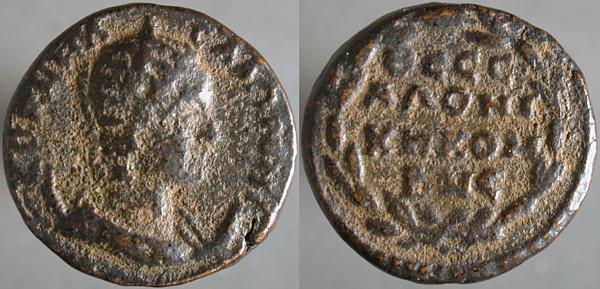
KOPNHΛ CAΛΩNINA, Diademed draped bust right on crescent | ΘECC / AΛONI / KH KON / B NE, Legend in four lines in wreath.
ΘECCAΛONKH indicates that this is a coin of Thessalonica (now Thessaloniki in Greece), which was the capitol of the province of Macedonia.
KON I don't know, and solicit information from anyone who does.
B NE declares that the city had two Neokorate temples, dedicated to the cult of the imperial family.

